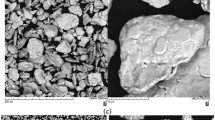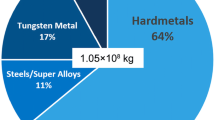The paper reviews and analyzes the areas for improving WC–Co hardmetals. One of the areas was initiated by Grygorii Samsonov in the mid-1950s and has proved to be relevant up to now. It deals with the development and study of hardmetals with an inhomogeneous structure resulting from nonuniform distribution of the carbide phase in samples with a cobalt binder. Samsonov showed in 1956 that the materials consisting of VK3 hardmetal grains embedded in a VK15 hardmetal matrix had very high wear resistance, surpassing the wear resistance of uniform VK3 and VK15 hardmetals by 8–10 times. Similar hardmetals but with a cobalt matrix were developed in the 2000s in the USA and were called ‘hybrid’ or ‘double’ hardmetals and later, in Ukraine, ‘mesostructural’ hardmetals. At a given level of hardness, such hardmetals show increased fracture toughness that determines their high wear resistance. Along with hybrid or mesostructural hardmetals, research efforts focusing on coarse-grained and ultracoarse-grained hardmetals, also promoting high wear resistance through increased fracture toughness and plastic strain energy, were resumed. The wear resistance of coarse-grained hardmetals was additionally increased in Germany through hardening of the cobalt matrix, specifically thick cobalt layers, by nanosized hard inclusions such as complex Co2W4C carbide (θ phase). Comparative wear resistance tests of the coarse-grained and ultrafinegrained hardmetals indicated that those with coarse WC particles were much more preferable. At the same time, the high wear resistance of ultrafine-grained hardmetals was found in abrasive wear tests at low loads.
















Similar content being viewed by others
References
V.S. Rakovski, G.V. Samsonov, and I.I. Olkhov, Fundamentals of Hardmetal Production [in Russian], Metallurgizdat, Moscow (1960), p. 232.
G.V. Samsonov, “Some trends in the development of new grades of cermet hardmetals,” in: New Materials in Mechanical Engineering [in Russian], Mashinostroenie, Moscow–Leningrad (1964), pp. 108–117.
N.A. Rozno, “Hardmetal grain tools for grinding wheel dressing,” in: Crush Dressing of Grinding Wheels [in Russian], Mashgiz, Moscow (1951), pp. 432–451.
G.A. Meerson and G.V. Samsonov, “Cermet hardmetals for unevenly distributed carbide component for abrasive material processing,” Izv. Akad. Nauk SSSR, No. 4, 121–125 (1956).
K.A. Bystrova and V.F. Funke, “Some properties of hardmetals with unevenly distributed cementing phase,” Izv. Akad. Nauk SSSR, No. 6, 37–41 (1958).
Y. Sun, W. Su, H. Yang, and J. Ruan, “Effects of WC particle size on sintering behavior and mechanical properties of coarse grained WC–8Co cemented carbides fabricated by unmilled composite powders,” Ceram. Int., 41, No. 10, 14482–14491 (2015).
H.E. Exner and J. Gurland, “A review of parameters influencing some mechanical properties of tungsten carbide-cobalt alloys,” Powder Metall., 13, No. 25, 13–31 (1970).
A.V. Laptev, S.S. Ponomarev, and L.F. Ochkas, “Study of possibility of solid phase producing poreless WC–26% Co hard metal at high energy pressing,” in: Proc. EURO PM'99 Conf. Advances in Hard Materials Production, Turin, Italy (1999), pp. 205–212.
A.I. Tolochin and A.V. Laptev, “Structure and properties of WC–36 Co composite produced from ultrafine WC + Co and WC + Co3O4 powder mixtures, ” Sverkhtverd. Mater., No. 6, 37–46 (2006).
A. Laptiev, Z. Pakiela, O. Tolochyn, and T. Brynk, “Microstructure and mechanical properties of WC–40Co composite obtained by impact sintering in solid state,” J. Alloys Compd., 687, 135–142 (2016).
B. Aronsson, “Structure and properties of dual properties carbide for rock drilling,” in: Proc. Advances in Hard Metals Production, Vol. 19, 1988, p. 1–6.
Zhigang Fang and J. Sue Albert, “Double cemented carbide composites,” US Patent No. 5,880,382, Smith International Inc.; Filed: July 31, 1997; Date of Patent: March 9, 1999; Int. Cl. C22C 29/00, US. Cl. 75/236.
Z. Fang, G. Lockwood, and A. Griffo, “A dual composite of WC–Co,” Metal. Mater. Trans. A, 30A, 3231–3238 (1999).
Z. Zak Fang, Anthony Griffo, Brian White, Greg Lockwood, Dan Belnap, Greg Hilmas, and Jonathan Bitler, “Fracture resistant super hard materials and hardmetals composite with functionally designed microstructure,” Int. J. Refract. Met. Hard Mater., 19, Nos. 4–6, 453–459 (2001).
Xin Deng, B.R. Patterson, K.K. Chawla, M.C. Koopman, Z. Fang, G. Lockwood, and A. Griffo, “Mechanical properties of a hybrid cemented carbide composite,” Int. J. Refract. Met. Hard Mater., 19, No. 4–6, 547–552 (2001).
J.R. Lizenby, K.J. Lizenby, and L.J. Barnard, “Self-sealing fluid die,” US Patent 4656002, April 7, 1987.
H. Berns and N. Chuong, “A new microstructure for PM tooling material,” Metallofiz. Noveish. Tekhnol., 18, No. 6, 62–71 (1996).
A.F. Lisovskii, “Mesostructuring in sintered hard alloys,” Powder Metall. Met. Ceram., 40, No. 1–2, 71–76 (2001).
V.I. Kushch, A.F. Lisovskii, and S.I. Shestakov, “Mesostructure modeling in sintered hardmetals,” Sverkhtverd. Mater., No. 3, 32–40 (2003).
A.F. Lisovskii, “Formation of mesostructures in sintered hardmetals and their properties,” Sverkhtverd. Mater., No. 4, 4–10 (2003).
A.F. Lisovskii, “Formation of mesostructure in WC–Co hardmetals,” Sverkhtverd. Mater., No. 2, 96–98 (2011).
A.F. Lisovskii, “Sintered hardmetals: self-organization of defects and structurization concept,” Sverkhtverd. Mater., No. 6, 48–53 (2001).
A.F. Lisovskii, S.A. Ivanov, and V.P. Pereyaslov, “On formation of mesostructures in sintered hardmetals,” Sverkhtverd. Mater., No. 1, 80–81 (2003).
G.S. Kreimer, O.S. Safonova, and E.M. Bogino, “Cermet hardmetals for rock drilling,” in: Hardmetals (Collected Papers) [in Russian], VNIITS, Metallurgiya, Moscow (1951), Issue 1, pp. 41–71.
V.A. Ivensen, Z.A. Goldberg, O.N. Eiduk, and V.A. Falkovskii, “Impact resistance of hardmetals,” in: Hardmetals (Collected Papers) [in Russian], VNIITS, Metallurgiya, Moscow (1965), Issue 6, pp. 199–208.
V.A. Falkovskii, Hardmetals for Metal Forming [in Russian], NIIMASH, Moscow (1978), p. 44.
A.S. Multanov, “Ultracoarse-grained WC–Co alloys for rock cutting tools of mining machines,” Fiz. Mesomekh., 5, No. 4, 113–116 (2002).
I. Konyashin, F. Schäfer, R. Cooper, B. Ries, J. Mayer, and T. Weirich, “Novel ultra-coarse hardmetal grades with reinforced binder for mining and construction,” Int. J. Refract. Met. Hard Mater., 23, No. 4–6, 225–232 (2005).
S. Okamoto, Y. Nakazono, K. Otsuka, Y. Shimoitani, and J. Takada, “Mechanical properties of WC/Co cemented carbide with larger WC grain size,” Mater. Charact., 55, 281–287 (2005).
V.P. Bondarenko, I.V. Andreyev, I.V. Savchuk, O.O. Matviichuk, O.V. Ievdokymova, and A.V. Galkov, “Recent researches on the metal-ceramic composites based on the decamicron-grained WC,” Int. J. Refract. Met. Hard Mater., 39, 18–31 (2013).
I. Konyashin, B. Ries, and F. Lachmann, “Near-nano WC–Co hardmetals: Will they substitute conventional coarse-grained mining grades?” Int. J. Refract. Met. Hard Mater., 28, No. 4, 489–497 (2010).
A.L. Greer and J.R. Wilde, “Novel Ni–TaC nanocrystalline cermets,” Mater. Sci. Forum, 360–362, 261–266 (2001).
Y. Zhuk, “Hardide: advanced nanostructured CVD coating,” Int. J. Microstruct. Mater. Prop., 2, No. 1, 90–98 (2007).
I. Konyashin and B. Ries, “Wear damage of cemented carbides with different combinations of WC mean grain size and Co content. Part II: Laboratory performance tests on rock cutting and drilling,” Int. J. Refract. Met. Hard Mater., 45, 230–237 (2014).
S. Lay, S. Hamar-Thibault, and A. Lackner, “Location of VC in VC, Cr3C2 codoped WC–Co cermets by HRTEM and EELS,” Int. J. Refract Met. Hard Mater., 20, 61–69 (2002).
J. Weidow and H-O. Andrén, “Grain and phase boundary segregation in WC–Co with TiC, ZrC, NbC or TaC additions,” Int. J. Refract Met. Hard Mater., 29, No. 1, 38–43 (2011).
I. Konyashin and B. Ries, “Wear damage of cemented carbides with different combinations of WC mean grain size and Co content. Part I: ASTM wear tests,” Int. J. Refract. Met. Hard Mater., 46, 12–19 (2014).
I. Konyashin, B. Ries, D. Hlawatschek, Y. Zhuk, A. Mazilkin, B. Straumal, F. Dorn, and D. Park, “Wearresistance and hardness: Are they directly related for nanostructured hard materials?” Int. J. Refract. Met. Hard Mater., 49, 203–211 (2015).
S. Luyckx, N. Sacks, and A. Love, “Increasing the abrasion resistance without decreasing the toughness of WC–Co of a wide range of compositions and grain sizes,” Int. J. Refract. Met. Hard Mater., 25, No. 1, 57–61 (2007).
D.G.F. O’Quigley, S. Luyckx, and M.N. James, “An empirical ranking of a wide range of WC–Co grades in terms of their abrasion resistance measured by the ASTM standard B611-85 test,” Int. J. Refract. Met. Hard Mater., 15, 73–79 (1997).
D.G.F. O’Quigley, S. Luyckx, and M.N. James, “New results on the relationship between hardness and fracture toughness of WC–Co hardmetal,” Mater. Sci. Eng., A209, 228–230 (1996).
Wei Su, Yan Wen, and Qinying Zhang, “Effects of Ni and Cu additions on microstructures, mechanical properties and wear resistances of ultra-coarse grained WC–6Co cemented carbides,” Int. J. Refract. Met. Hard Mater., 70, 176–183 (2018).
Author information
Authors and Affiliations
Corresponding author
Additional information
Translated from Poroshkova Metallurgiya, Vol. 58, Nos. 1–2 (525), pp. 57–76, 2019.
Rights and permissions
About this article
Cite this article
Laptiev, A. Some Trends in Improving WC–Co Hardmetals. I. Hybrid and Coarse-Grained Hardmetals. Powder Metall Met Ceram 58, 42–57 (2019). https://doi.org/10.1007/s11106-019-00046-3
Received:
Published:
Issue Date:
DOI: https://doi.org/10.1007/s11106-019-00046-3




